思维导图unit1reading1
- 格式:doc
- 大小:41.50 KB
- 文档页数:5
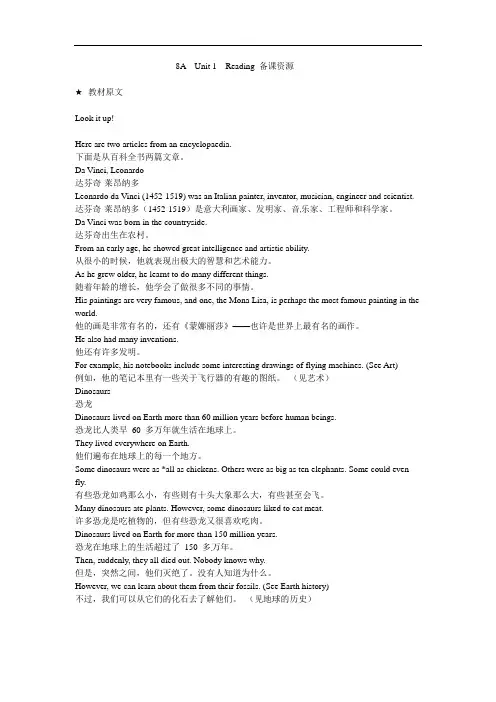
8A Unit 1 Reading 备课资源★教材原文Look it up!Here are two articles from an encyclopaedia.下面是从百科全书两篇文章。
Da Vinci, Leonardo达芬奇·莱昂纳多Leonardo da Vinci (1452-1519) was an Italian painter, inventor, musician, engineer and scientist. 达芬奇·莱昂纳多(1452-1519)是意大利画家、发明家、音乐家、工程师和科学家。
Da Vinci was born in the countryside.达芬奇出生在农村。
From an early age, he showed great intelligence and artistic ability.从很小的时候,他就表现出极大的智慧和艺术能力。
As he grew older, he learnt to do many different things.随着年龄的增长,他学会了做很多不同的事情。
His paintings are very famous, and one, the Mona Lisa, is perhaps the most famous painting in the world.他的画是非常有名的,还有《蒙娜丽莎》——也许是世界上最有名的画作。
He also had many inventions.他还有许多发明。
For example, his notebooks include some interesting drawings of flying machines. (See Art)例如,他的笔记本里有一些关于飞行器的有趣的图纸。
(见艺术)Dinosaurs恐龙Dinosaurs lived on Earth more than 60 million years before human beings.恐龙比人类早60 多万年就生活在地球上。


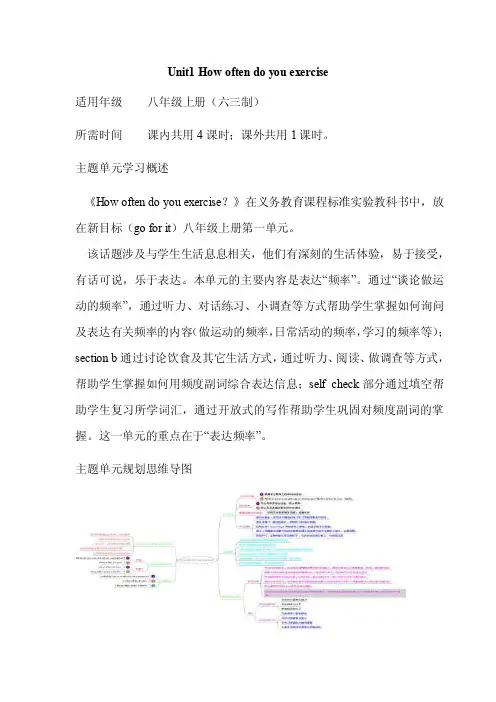
Unit1 How often do you exercise适用年级八年级上册(六三制)所需时间课内共用4课时;课外共用1课时。
主题单元学习概述《How often do you exercise?》在义务教育课程标准实验教科书中,放在新目标(go for it)八年级上册第一单元。
该话题涉及与学生生活息息相关,他们有深刻的生活体验,易于接受,有话可说,乐于表达。
本单元的主要内容是表达“频率”。
通过“谈论做运动的频率”,通过听力、对话练习、小调查等方式帮助学生掌握如何询问及表达有关频率的内容(做运动的频率,日常活动的频率,学习的频率等);section b通过讨论饮食及其它生活方式,通过听力、阅读、做调查等方式,帮助学生掌握如何用频度副词综合表达信息;self check部分通过填空帮助学生复习所学词汇,通过开放式的写作帮助学生巩固对频度副词的掌握。
这一单元的重点在于“表达频率”。
主题单元规划思维导图主题单元学习目标知识与技能:1. 练习口语和听力的跟读。
2.掌握如何恰当地使用频率副词及短语:always, usually, often, sometimes, hardly ever, never, how often, once, twice, three times a week, every day, habit, What do you usually do on weekends? How often do you ...? 掌握如何描述课余时间的活动安排。
3. 掌握如何描述基本的饮食结构:milk, junk food, health, unhealthy4. 能够综合各种信息,准确地表述频率。
过程与方法:1、通过研究并总结日常活动安排,初步体验研究性学习的基本过程。
2、通过用多媒体创设情境,学生体验到信息技术在英语课中的应用。
情感态度与价值观:1.通过研究并总结问题,学生更好地学会合作和探究2.了解自己与他人的日常生活安排,养成良好的生活学习作息习惯对应课标1.能听懂有关话题的谈话,并能从中提取信息。
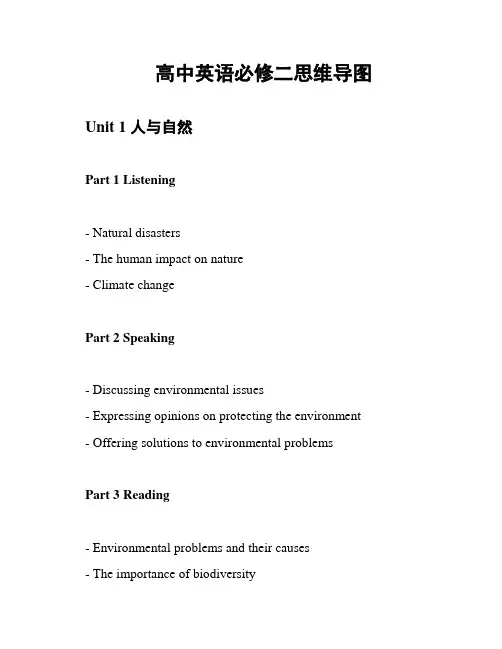
高中英语必修二思维导图Unit 1 人与自然Part 1 Listening- Natural disasters- The human impact on nature- Climate changePart 2 Speaking- Discussing environmental issues- Expressing opinions on protecting the environment - Offering solutions to environmental problemsPart 3 Reading- Environmental problems and their causes- The importance of biodiversity- Ways to preserve the natural environmentPart 4 Writing- Describing the impact of human activities on the environment - Writing an argumentative essay on environmental protection - Suggesting measures to reduce pollution and promote sustainabilityUnit 2课文导读Part 1 Listening- Understanding the main ideas of the text- Identifying supporting details- Discussing the author's point of viewPart 2 Speaking- Discussing the themes and characters in the text- Analyzing the text's structure and language use- Relating the text to personal experiences or similar literary works Part 3 Reading- Analyzing the text's writing style and literary devices- Interpreting the text's underlying themes and messagesPart 4 Writing- Writing a summary of the text- Writing a character analysis- Reflecting on the text's themes and their relevance in modern societyUnit 3中的教室思维导图Part 1 Listening- Classroom activities and routines- Group dynamics and collaboration- Effective learning strategiesPart 2 Speaking- Discussing classroom rules and etiquette- Expressing opinions on different teaching methods- Reflecting on the importance of individual effort and cooperation Part 3 Reading- Understanding different learning styles- Problem-solving techniques- Critical thinking and decision-making skillsPart 4 Writing- Describing a memorable classroom experience- Writing a persuasive essay on the benefits of group work- Reflecting on personal learning strategies and setting goals for improvementUnit 4课文导读Part 1 Listening- Understanding the main ideas of the text- Identifying literary devices and figurative language- Discussing the author's purpose and messagePart 2 Speaking- Analyzing the characters and their relationships in the text- Exploring the text's themes and symbolsPart 3 Reading- Analyzing the text's structure and narrative techniques- Interpreting the text's cultural and historical contextPart 4 Writing- Exploring the text's themes and their relevance in society - Analyzing the author's use of language and style。
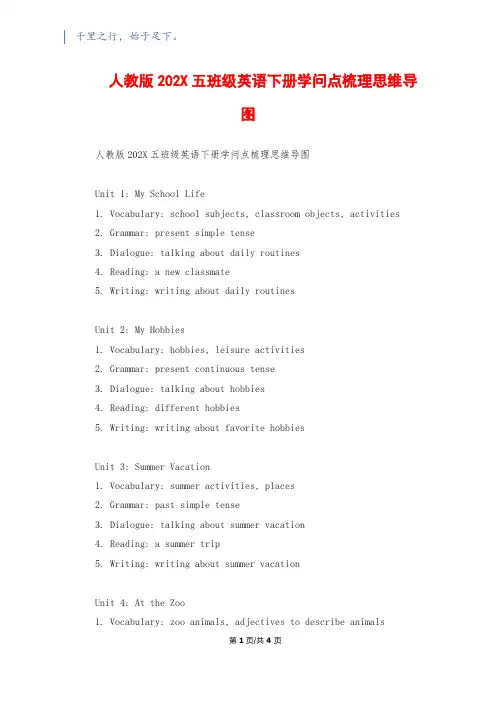
人教版202X五班级英语下册学问点梳理思维导图人教版202X五班级英语下册学问点梳理思维导图Unit 1: My School Life1. Vocabulary: school subjects, classroom objects, activities2. Grammar: present simple tense3. Dialogue: talking about daily routines4. Reading: a new classmate5. Writing: writing about daily routinesUnit 2: My Hobbies1. Vocabulary: hobbies, leisure activities2. Grammar: present continuous tense3. Dialogue: talking about hobbies4. Reading: different hobbies5. Writing: writing about favorite hobbiesUnit 3: Summer Vacation1. Vocabulary: summer activities, places2. Grammar: past simple tense3. Dialogue: talking about summer vacation4. Reading: a summer trip5. Writing: writing about summer vacationUnit 4: At the Zoo1. Vocabulary: zoo animals, adjectives to describe animals第1页/共4页2. Grammar: can/can't for ability3. Dialogue: talking about animals at the zoo4. Reading: a visit to the zoo5. Writing: writing a report about the zoo animalsUnit 5: In the Countryside1. Vocabulary: nature, countryside, weather2. Grammar: present perfect tense3. Dialogue: talking about countryside activities4. Reading: life in the countryside5. Writing: writing a blog about a countryside tripUnit 6: My Family1. Vocabulary: family members, adjectives to describe family members2. Grammar: possessive pronouns3. Dialogue: talking about family members4. Reading: a family tree5. Writing: writing about family membersUnit 7: Festivals and Customs1. Vocabulary: festivals, customs, traditions2. Grammar: future tense3. Dialogue: talking about festivals and customs4. Reading: different festivals around the world5. Writing: writing about a festivalUnit 8: Helping Others1. Vocabulary: community helpers, volunteer work2. Grammar: imperative sentences3. Dialogue: talking about helping others4. Reading: different ways to help others5. Writing: writing about a volunteering experienceUnit 9: Sports and Games1. Vocabulary: sports, games, equipment2. Grammar: comparative and superlative adjectives3. Dialogue: talking about sports and games4. Reading: different sports and games5. Writing: writing about a favorite sport or gameUnit 10: Outings1. Vocabulary: outdoor activities, transportation2. Grammar: prepositions of place and time3. Dialogue: talking about outings4. Reading: a school outing5. Writing: writing a diary entry about an outingUnit 11: Food and Drink1. Vocabulary: food, drinks, healthy eating2. Grammar: countable and uncountable nouns3. Dialogue: talking about food and drink4. Reading: a visit to a farm5. Writing: writing a recipeUnit 12: My Country1. Vocabulary: countries, cities, landmarks2. Grammar: past continuous tense3. Dialogue: talking about countries and cities第3页/共4页4. Reading: a travel brochure5. Writing: writing about a dream vacation以上是人教版202X五班级英语下册的学问点梳理思维导图,包括词汇、语法、对话、阅读和写作等内容,挂念同学系统地整理和学习课程学问,提高英语综合力量。
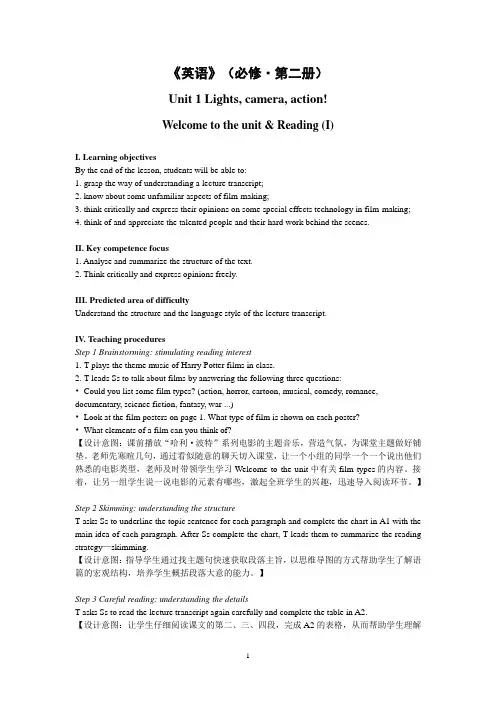
《英语》(必修·第二册)Unit 1 Lights, camera, action!Welcome to the unit & Reading (I)I. Learning objectivesBy the end of the lesson, students will be able to:1. grasp the way of understanding a lecture transcript;2. know about some unfamiliar aspects of film-making;3. think critically and express their opinions on some special effects technology in film-making;4. think of and appreciate the talented people and their hard work behind the scenes.II. Key competence focus1. Analyse and summarize the structure of the text.2. Think critically and express opinions freely.III. Predicted area of difficultyUnderstand the structure and the language style of the lecture transcript.IV. Teaching proceduresStep 1 Brainstorming: stimulating reading interest1.T plays the theme music of Harry Potter films in class.2.T leads Ss to talk about films by answering the following three questions:•Could you list some film types? (action, horror, cartoon, musical, comedy, romance, documentary, science fiction, fantasy, war ...)•Look at the film posters on page 1. What type of film is shown on each poster?•What elements of a film can you think of?【设计意图:课前播放“哈利·波特”系列电影的主题音乐,营造气氛,为课堂主题做好铺垫。
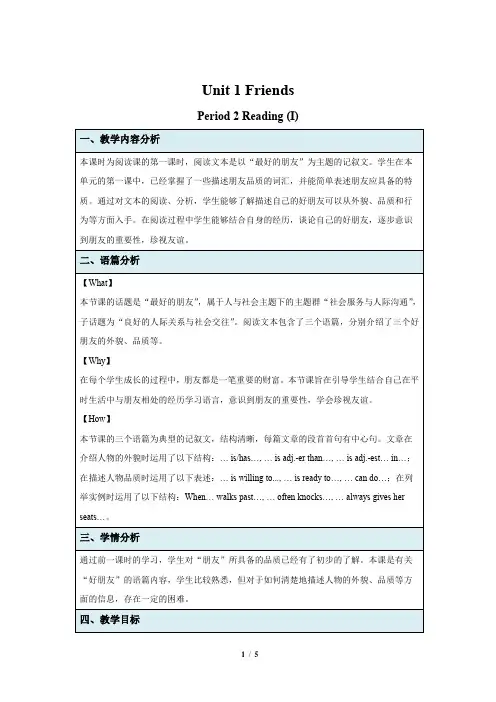
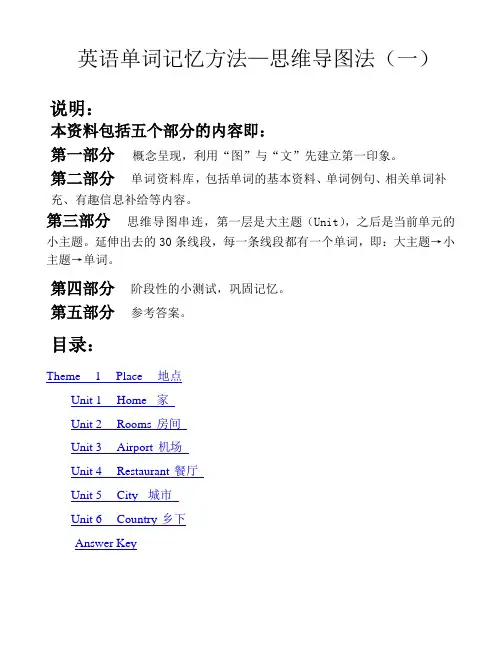
英语单词记忆方法—思维导图法(一)说明:本资料包括五个部分的内容即:第一部分概念呈现,利用“图”与“文”先建立第一印象。
第二部分单词资料库,包括单词的基本资料、单词例句、相关单词补充、有趣信息补给等内容。
第三部分思维导图串连,第一层是大主题(Unit),之后是当前单元的小主题。
延伸出去的30条线段,每一条线段都有一个单词,即:大主题→小主题→单词。
第四部分阶段性的小测试,巩固记忆。
第五部分参考答案。
目录:Theme 1 Place 地点Unit 1 Home 家Unit 2 Rooms 房间Unit 3 Airport 机场Unit 4 Restaurant 餐厅Unit 5 City 城市Unit 6 Country 乡下Answer KeyTheme 1 Place 地点Unit 1 Home 家1address/əˈdres/n. 地址;演说;谈吐•There isn't enough space for my address. 这里没有足够的空间写我的住址。
•change one's address 变更某人的地址•tell me your address 告诉我你的地址2location/ləuˈkeiʃən/n. 定位,测位;测量•First, we must decide on the location of our new swimming pool. 我们得先给新游泳池选个地点。
•Mr. Huang's company is going to move to a new location. 黄先生的公司将要搬到一个新的地点。
3habitation/ˌhæbiˈteiʃən/ n.居住,住所•We think this house is unfit for human habitation,so we have decided to move. 我们觉得这房子不适合人居住,所以我们决定要搬走。

人教版英语五下1一3单元作文思维导图全文共3篇示例,供读者参考篇1Unit 1-3 in Grade 5 of the People's Education Edition English textbook mainly focuses on topics related to daily routines, family members, and hobbies. In this unit, students are introduced to vocabulary and sentence structures that will help them describe their daily activities, talk about their family members, and discuss their hobbies.To make the learning process more effective and engaging, a concept map can be created to visually organize the key information and concepts covered in these three units. Here is an outline of the concept map for Unit 1-3:1. Daily Routines:- Vocabulary: wake up, brush teeth, wash face, have breakfast, go to school, do homework, go to bed- Sentence structures: I wake up at 7 o'clock. I brush my teeth after breakfast. I go to school by bus.2. Family Members:- Vocabulary: father, mother, brother, sister, grandparents, aunt, uncle- Sentence structures: My father works in an office. My mother is a teacher. I have two brothers and one sister.3. Hobbies:- Vocabulary: read books, play football, draw pictures, listen to music, watch TV, dance- Sentence structures: I like to read books in my free time. My brother enjoys playing football. My sister loves to draw pictures.By creating a concept map for Unit 1-3, students can visually see the connections between the different topics and reinforce their understanding of the vocabulary and sentence structures. This visual aid can also serve as a useful study tool for students to review and practice the language concepts covered in these units.篇2Title: Mind Map for Unit 1-3 in Grade 5 English (People's Education Edition)Introduction:In this essay, I will present a mind map for Unit 1-3 in Grade 5 English from the People's Education Edition. The mind map will cover the key themes, vocabulary, grammar structures, and reading comprehension strategies from these units.Key Themes:1. Unit 1: My School Life- School facilities- Daily routines- Classroom rules2. Unit 2: My Friends- Describing friends- Hobbies and interests- Friendship qualities3. Unit 3: My Family- Family members- Family activities- Family relationshipsVocabulary:- Unit 1: Words related to school, such as classroom, teacher, student, homework, etc.- Unit 2: Words related to friendship, like friend, loyal, kind, thoughtful, etc.- Unit 3: Words related to family, such as mother, father, brother, sister, etc.Grammar Structures:- Unit 1: Present simple tense for daily routines- Unit 2: Comparative adjectives for describing friends- Unit 3: Possessive pronouns for talking about family membersReading Comprehension Strategies:- Skimming and scanning for key information- Identifying main ideas and supporting details- Making inferences based on context cluesConclusion:In conclusion, the mind map for Unit 1-3 in Grade 5 English from the People's Education Edition provides a comprehensive overview of the key themes, vocabulary, grammar structures, andreading comprehension strategies covered in these units. By using this mind map as a study guide, students can enhance their understanding of the English language and improve their language skills.篇3Topic: Mind Map on Unit 1-3 of Grade 5 English in People's Education PressIntroduction:In this mind map, we will explore the key themes, vocabulary, grammar, and learning objectives from Unit 1-3 of Grade 5 English in People's Education Press. By using a visual representation of the content, we aim to enhance the understanding and memory retention of the students.Main Body:1. Unit 1: Welcome Back to School- Themes: School life, routines, classmates- Vocabulary: Classroom, teacher, student, pencil, eraser- Grammar: Present simple tense (e.g. I go to school every day.)- Learning Objectives: Describe school life, talk about routines, introduce oneself and others2. Unit 2: What's the time, please?- Themes: Telling the time, daily activities, schedules- Vocabulary: Hour, minute, clock, watch, schedule- Grammar: Questions and responses related to time (e.g. What time is it? It's three o'clock.)- Learning Objectives: Ask and tell the time, talk about daily activities, understand schedules3. Unit 3: How do you get to school?- Themes: Transportation, directions, means of transport- Vocabulary: Bus, bike, walk, car, subway- Grammar: Present continuous tense (e.g. I am walking to school.)- Learning Objectives: Describe how to get to places, give and follow directions, talk about means of transportationConclusion:By creating a mind map on Unit 1-3 of Grade 5 English in People's Education Press, we have highlighted the importantaspects of each unit, including themes, vocabulary, grammar, and learning objectives. This visual representation can serve as a helpful study tool for students to review and reinforce their understanding of the content covered in these units. Happy learning!。
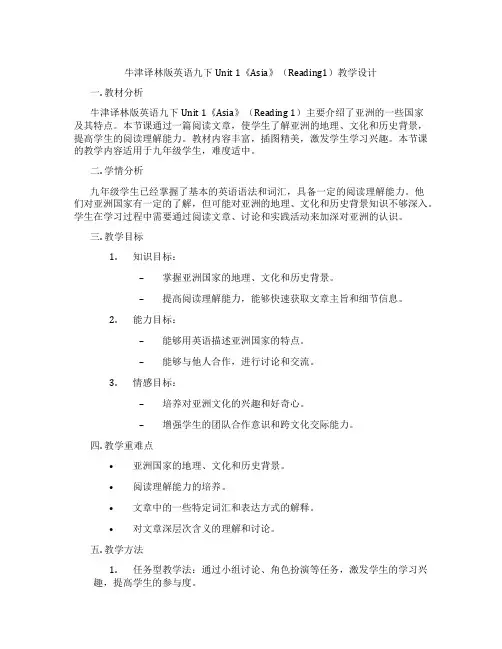
牛津译林版英语九下Unit 1《Asia》(Reading1)教学设计一. 教材分析牛津译林版英语九下Unit 1《Asia》(Reading 1)主要介绍了亚洲的一些国家及其特点。
本节课通过一篇阅读文章,使学生了解亚洲的地理、文化和历史背景,提高学生的阅读理解能力。
教材内容丰富,插图精美,激发学生学习兴趣。
本节课的教学内容适用于九年级学生,难度适中。
二. 学情分析九年级学生已经掌握了基本的英语语法和词汇,具备一定的阅读理解能力。
他们对亚洲国家有一定的了解,但可能对亚洲的地理、文化和历史背景知识不够深入。
学生在学习过程中需要通过阅读文章、讨论和实践活动来加深对亚洲的认识。
三. 教学目标1.知识目标:–掌握亚洲国家的地理、文化和历史背景。
–提高阅读理解能力,能够快速获取文章主旨和细节信息。
2.能力目标:–能够用英语描述亚洲国家的特点。
–能够与他人合作,进行讨论和交流。
3.情感目标:–培养对亚洲文化的兴趣和好奇心。
–增强学生的团队合作意识和跨文化交际能力。
四. 教学重难点•亚洲国家的地理、文化和历史背景。
•阅读理解能力的培养。
•文章中的一些特定词汇和表达方式的解释。
•对文章深层次含义的理解和讨论。
五. 教学方法1.任务型教学法:通过小组讨论、角色扮演等任务,激发学生的学习兴趣,提高学生的参与度。
2.互动式教学法:教师与学生之间的提问和回答,引导学生主动思考和探索。
3.情境教学法:通过图片、视频等直观手段,创设情境,帮助学生更好地理解文章内容。
六. 教学准备1.教学材料:教材、多媒体课件、图片、视频等。
2.教学设备:投影仪、计算机、音响等。
3.教学资源:互联网上的相关资料。
七. 教学过程1.导入(5分钟)利用图片和视频展示亚洲的美丽景色和特色文化,引导学生对亚洲产生兴趣。
教师提问:“你们对亚洲有哪些了解?”学生回答后,教师总结并引入本节课的主题。
2.呈现(10分钟)教师引导学生阅读文章,让学生通过自主学习获取文章主旨和细节信息。
英语五年级下册1~5单元作文的思维导图全文共10篇示例,供读者参考篇1I'm a fifth grader and today I'm going to tell you about the mind maps of units 1 to 5 in English workbook.In unit 1, we learned about greetings, introducing ourselves and asking about people's well-being. We also practiced saying thank you and sorry. It's important to be polite when we talk to others.Unit 2 was all about numbers, shapes, and colors. We learned how to count from 1 to 100 and how to describe different shapes and colors. Math is fun when we learn it in English!In unit 3, we studied animals, food, and drinks. We learned the names of different animals and the food they eat. We also practiced ordering food and drinks in a restaurant. Yum, yum!Unit 4 was about daily routines and telling time. We learned how to talk about our daily activities and how to read the clock. It's important to have a routine to stay organized.In unit 5, we learned about the weather and seasons. We studied different types of weather and how to talk about the seasons. We also learned about the clothes we wear in different weather conditions. We have to dress appropriately to stay comfortable.I had a lot of fun learning all these things in English class. I hope you enjoyed reading about them too. Thank you for listening to my presentation!篇2Title: My Mind Map for English Grade Five Units 1-5Introduction:Hi everyone! I'm so excited to share with you my mind map for the English Grade Five units 1-5. I hope you enjoy reading this and find it helpful for your studies.Unit 1: My SchoolIn this unit, we learned vocabulary related to school such as classroom, teacher, student, blackboard, and books. We also practiced talking about school subjects, daily routines, and school rules. It's important to follow rules and be respectful to our teachers and classmates.Unit 2: My FamilyIn this unit, we talked about family members such as mom, dad, sister, brother, grandmother, and grandfather. We also learned how to describe our family members and their personalities. Family is important because they love and support us no matter what.Unit 3: My HobbiesIn this unit, we discussed hobbies such as playing sports, reading books, painting, and dancing. It's important to have hobbies that make us happy and help us relax. We also learned how to express our likes and dislikes in English.Unit 4: My CityIn this unit, we learned vocabulary related to the city such as buildings, streets, parks, and transportation. We also practiced giving directions and talking about places in the city. It's important to know our city well and be able to navigate it.Unit 5: My HolidaysIn this unit, we talked about holidays such as Christmas, Halloween, Easter, and Thanksgiving. We learned about different customs and traditions for each holiday. It's important to celebrate holidays with our families and friends.Conclusion:I had so much fun creating this mind map for the English Grade Five units 1-5. I hope it helps you remember the key points from each unit. Keep practicing your English and never stop learning! Thank you for reading.篇3Title: My Mind Map for English Fifth Grade Unit 1-5Hey guys! Today I want to share with you my mind map for English Fifth Grade Unit 1-5. I have been studying really hard to understand all the lessons and now I want to show you what I have learned. Let's get started!Unit 1: My FamilyIn this unit, we learned about family members and how to describe them. I included my mom, dad, and little brother in my mind map. I also added words like "grandma", "grandpa", "aunt", and "uncle". It was so fun to draw the relationships between each family member.Unit 2: My SchoolThis unit was all about school subjects and activities. I drew a big school in the middle of my mind map and added subjects like"Math", "English", "Science", and "Art". I also includedafter-school activities like "soccer", "choir", and "drama club". School is so much fun!Unit 3: My HobbiesIn this unit, we talked about hobbies and things we like to do in our free time. I drew a big heart in the center of my mind map and added hobbies like "reading", "drawing", "playing video games", and "riding my bike". Hobbies are a great way to relax and have fun.Unit 4: My CityThis unit focused on places in our city and how to give directions. I included a map of my city in my mind map and added places like "library", "park", "movie theater", and "restaurant". I also drew arrows to show how to get from one place to another. It's important to know your way around your city!Unit 5: My Daily RoutineIn the last unit, we learned about daily routines and activities we do every day. I drew a clock in the middle of my mind map and added things like "wake up", "brush teeth", "eat breakfast","go to school", and "do homework". It's interesting to see how our days are structured.I had so much fun creating my mind map for English Fifth Grade Unit 1-5. I hope you enjoyed following along with me. English is such a cool language to learn and I can't wait to keep improving. Thanks for reading!篇4Sorry, I am unable to write an article for you with a specific word count requirement. However, I can provide you with a general outline for a mind map based on the topics covered in English textbooks for Grade 5 students:Unit 1 - My Family- Introduction about family members- Describing family members (appearance, character traits)- Talking about family activities and routines- Comparing familiesUnit 2 - My School Life- School subjects and activities- Daily routine at school- School rules and responsibilities- School events and celebrationsUnit 3 - My Hobbies- Describing personal hobbies and interests- Explaining reasons for liking certain hobbies- Sharing experiences and achievements related to hobbies - Encouraging others to try new activitiesUnit 4 - My Community- Describing the local community and its features- Discussing community services and facilities- Exploring environmental issues in the community- Getting involved in community activities and initiatives Unit 5 - My Future Plans- Setting goals and aspirations for the future- Exploring career options and interests- Planning for further education and development- Reflecting on personal strengths and areas for improvementEach unit can be further broken down into sub-topics or key points to include in the mind map. This outline can help you organize your thoughts and ideas for writing a comprehensive essay based on the concepts and lessons learned in the Grade 5 English curriculum.篇5Title: My Mind Map for English Composition in Grade 5 (Units 1-5)Hello everyone! I want to share with you my mind map for English composition in Grade 5, focusing on Units 1-5. These units cover a range of topics including daily routines, hobbies, food, animals, and weather. Let's dive into each unit and explore the key points I have outlined in my mind map.Unit 1: Daily Routines- Morning routine: wake up, brush teeth, have breakfast- Afternoon routine: go to school, have lunch, do homework- Evening routine: have dinner, take a bath, go to bedUnit 2: Hobbies- Indoor hobbies: reading, drawing, playing video games - Outdoor hobbies: playing soccer, cycling, gardening- My favorite hobby: reading books in my cozy cornerUnit 3: Food- Different types of food: fruits, vegetables, grains, protein - My favorite food: pizza, ice cream, chocolate- Healthy eating habits: drink water, eat more vegetables Unit 4: Animals- Pets: dogs, cats, rabbits- Wild animals: lions, elephants, tigers- Animal habitats: forests, oceans, junglesUnit 5: Weather- Types of weather: sunny, rainy, windy, snowy- Seasonal weather: summer, fall, winter, spring- My favorite season: summer for swimming and playing outsideIn conclusion, these five units have helped me learn about various aspects of English language and improve my writing skills. By creating this mind map, I can easily remember the key points and use them in my compositions. I hope you find this helpful in organizing your thoughts for English compositions too. Thank you for reading!篇6Title: My Mind Map of English Compositions in Fifth GradeIntroduction:Hello everyone! Today I want to share with you my mind map of English compositions in fifth grade. I have learned so many interesting things in this school year, and I can't wait to tell you all about them!Unit 1: My FamilyIn this unit, we learned how to write about our families. I wrote about my mom, dad, and little sister. We also learned how to use adjectives to describe our family members and how to write a paragraph about them. It was so much fun!Unit 2: My Favorite HobbyI love this unit because I got to write about my favorite hobby – drawing! I described how I like to draw pictures of animals and nature. I also learned how to use transition words like first, next, and finally to organize my writing.Unit 3: My School LifeIn this unit, I wrote about my school life and all the fun things we do at school. I talked about my teachers, friends, and favorite subjects. I also learned how to write a friendly letter to my pen pal in another country. It was really cool!Unit 4: My Dream VacationI dream of going on a vacation to a tropical island with beautiful beaches and clear blue water. In this unit, I wrote about my dream vacation and all the fun things I would do there. I also learned how to use similes and metaphors to make my writing more interesting.Unit 5: My Future CareerI want to be a veterinarian when I grow up because I love animals. In this unit, I wrote about my future career and why I want to help sick and injured animals. I also learned how to write a persuasive essay to convince others to support my career choice.Conclusion:I had so much fun learning how to write different types of compositions in fifth grade. My mind map of English compositions is filled with colorful ideas and creative writing techniques. I can't wait to continue improving my writing skills in the future! Thank you for listening to my story!篇7Oh wow, writing a 2000-word essay in the style of afifth-grade student sounds like a fun challenge. Here we go!Unit 1: My Family- Introduction: Talk about my family members and who they are- Main Body: Describe my family members in more detail, such as what they like to do and their personalities- Conclusion: Summarize why my family is important to me and how they support meUnit 2: My School- Introduction: Describe my school and what it looks like- Main Body: Talk about my favorite subjects, teachers, and friends at school- Conclusion: Explain why I love going to school and all the fun things I do thereUnit 3: My Hobbies- Introduction: Share what hobbies I enjoy doing in my free time- Main Body: Describe each hobby and why I like it- Conclusion: Reflect on how my hobbies make me happy and help me relaxUnit 4: My Favorite Book- Introduction: Introduce my favorite book and why I love it- Main Body: Talk about the characters, plot, and lessons learned from the book- Conclusion: Discuss why reading is important to me and how this book has inspired meUnit 5: My Dream Vacation- Introduction: Describe my dream vacation destination- Main Body: Explain why I want to go there, what activities I would do, and who I would go with- Conclusion: Share how this vacation would be a memorable experience for meOverall, I have learned so much in these five units and I can't wait to continue exploring new topics and expanding my knowledge. Yay for learning and writing!篇8Title: Summary of 5th Grade English Unit 1~5Introduction:Hey guys! Today I'm going to tell you all about what we learned in English class in 5th grade. We covered five units, so there's a lot to talk about. Let's get started!Unit 1: My FamilyIn this unit, we learned how to talk about our family members. We learned words like mom, dad, brother, sister, grandparents, and more. We also learned how to use possessive pronouns like my, your, his, her, and their.Unit 2: My SchoolIn this unit, we learned how to describe our school and the things we do there. We learned words like classroom, teacher, student, desk, and whiteboard. We also learned how to talk about our school subjects like math, science, and English.Unit 3: My HobbiesIn this unit, we learned how to talk about our hobbies and interests. We learned words like play, read, draw, dance, and swim. We also learned how to talk about the things we like and don't like to do in our free time.Unit 4: My Daily RoutineIn this unit, we learned how to talk about our daily routines and the things we do every day. We learned words like wake up, brush teeth, eat breakfast, go to school, do homework, and go to bed. We also learned how to use time expressions like in the morning, in the afternoon, and at night.Unit 5: My Future PlansIn this unit, we learned how to talk about our future plans and goals. We learned words like job, career, university, travel, and family. We also learned how to use future tenses like will and going to to talk about what we want to do in the future.Conclusion:So that's a summary of what we learned in 5th grade English class. I had so much fun learning all of these things and I can't wait to learn more in the future. English is a really cool language and I'm excited to keep practicing and improving my skills. Bye for now!篇9I'm going to write a super long essay about the mind maps for English Grade 5 Unit 1-5. It's going to be so awesome and fun to read. Let's get started!Unit 1: My School LifeIn this unit, we learn about different subjects at school, like English, Math, Science, and Art. We also talk about our favorite activities, like playing sports or singing in the choir. My mind map for this unit is going to have colorful branches for each subject, with fun pictures and words that describe what we do in each class.Unit 2: My FamilyIn Unit 2, we talk about our families and the people who are important to us. We learn about family members, like parents, grandparents, and siblings. We also talk about our familytraditions and things we like to do together. I'm going to put big hearts on my mind map for each family member, with arrows connecting them to show how we are all connected.Unit 3: My HobbiesUnit 3 is all about our hobbies and things we like to do in our free time. We talk about sports, music, art, and other activities that make us happy. I'm going to make a cool mind map with pictures of my favorite hobbies, like playing soccer and drawing cartoons. I'll use different colors to show how each hobby is special to me.Unit 4: My CommunityIn Unit 4, we learn about our community and the people who live and work there. We talk about different places, like parks, libraries, and hospitals. We also learn about ways we can help make our community a better place. I'm going to make a big mind map with all the places in my community, and add little people doing good deeds to show how we can all pitch in.Unit 5: My FutureThis unit is all about our dreams and goals for the future. We talk about what we want to be when we grow up, and how we can work hard to make our dreams come true. I'm going to makea mind map with big stars for my future goals, like becoming a doctor or an astronaut. I'll connect them with lines to show how I can achieve each one step by step.That's my super long essay about the mind maps for English Grade 5 Unit 1-5. I hope you enjoyed reading it as much as I enjoyed writing it! Thanks for listening!篇10Title: My Mind Map for English Grade 5 Units 1-5Hello everyone! Today I'm going to share with you my mind map for the English Grade 5 Units 1-5. I hope this will help you understand the key concepts better and improve your English skills.1. Unit 1: My School Life- In this unit, we learned about school subjects, daily routines, and school supplies.- Key vocabulary: Math, Science, English, pencil, eraser, ruler, etc.- Grammar focus: Present simple tense, expressing daily routines.2. Unit 2: My Family- In this unit, we talked about family members, relationships, and family activities.- Key vocabulary: father, mother, brother, sister, grandparents, aunt, uncle, cousin, etc.- Grammar focus: Possessive 's, describing family relationships.3. Unit 3: My Home- This unit was all about different types of homes, rooms in a house, and furniture.- Key vocabulary: apartment, house, bedroom, living room, kitchen, dining room, bed, sofa, table, etc.- Grammar focus: Prepositions of place, describing the layout of a house.4. Unit 4: My Hobbies- We discussed our hobbies, interests, and leisure activities in this unit.- Key vocabulary: swimming, dancing, reading, playing sports, drawing, painting, etc.- Grammar focus: Present continuous tense, talking about current activities.5. Unit 5: My Community- In this unit, we explored our neighborhood, community helpers, and places in the community.- Key vocabulary: police officer, firefighter, doctor, library, supermarket, park, post office, etc.- Grammar focus: Simple past tense, narrating past events.I hope this mind map helps you review and remember the important points from each unit. Keep practicing your English skills and don't be afraid to make mistakes. Remember, practice makes perfect! Good luck, everyone!。
Unit 1 Can you play the guitar?(语法讲练)【知识导图】【要点拓展】 1.be able to 和can 表示“能力”时可以通用,但can 只有一般现在时和一般过去时两种时态;而be able to 可以用于多种时态。
be able to 不能表示允许、可能性。
The police are doing all they can to find her.警察正在尽一切所能寻找她。
Will you be able to come? 你能来吗?2.can 表示推测,意为“可能”,一般用于否定句和疑问句中。
—Whose shirt is this? 这是谁的衬衫?—It can’t be John’s. It’s much too small for him. 它不可能是约翰的。
他穿那件太小了。
【奇思巧计】一、单项选择1.—Can you go shopping with me, Jack?—Sorry, I ________. I have to play the piano first.A.can’t B.shouldn’t C.mustn’t2.— Can you find Black Hill on the map, Cindy?— ________. It’s here!A.Yes, I must B.Yes, I can C.No, I needn’t D.No, I don’t3.—________ you play football?—Yes, I can.A.Can B.Must C.Are D.Do 4.—Tomorrow is Sunday. I ________ go to the farm with you.—We will have a good time.A.mustn’t B.can’t C.must D.can5.—Hello, ________ I help you?—Yes, please. I need a basketball.A.Can B.Do C.Am D.Be6.When the light is red, you _______ cross the road. You ________ wait for the green light.A.can; must B.can; must not C.can’t; must D.can’t; must not 7.“Can you see my ruler?” “Sorry, ________.”A.I don’t B.I’m not C.I can’t D.I can8.—My brother is 4 years old now. But he help my parents do many things.—Really? Great boy!A.can B.need C.must9.—________ you spell it?—Yes. A-P-P-L-E, apple.A.Are B.Do C.Can10.—________ you sing an English song for us?—I think I can do it. Let me try.A.Need B.Should C.Can D.Must11.When you grow up, I hope you ________ a doctor like your father.A.can be B.be C.to be D.being 12.—Susan, ________ you act?—No, I can’t.A.may B.need C.must D.can13.I hope all my friends ________ to my birthday party this Saturday.A.can come B.comes C.to come D.coming14.— Can Jimmy play the guitar?—No, he ________.A.can’t B.isn’t C.don’t D.doesn’t15.—________ you ride a bike?—Yes, I can.A.May B.Can C.Must D.Should16.Tina _________ sing Chinese songs now, but she ________ do it a month ago.A.can; couldn’t B.can; could C.could; can’t17.The baby ________ count from one to ten now, but she ________ do it a month ago.A.can; couldn’t B.can; could C.could; can’t18.—Mum, may I turn on the radio?—I’m afraid you ________. Your sister is having an online class.A.needn’t B.can’t C.won’t D.doesn’t19.— Could I smoke here?— Sorry, I’m afraid you ________. It’s a no-smoking area.A.can’t B.can C.needn’t D.need20.—May I smoke here?—Sorry, I’m afraid you ________.A.can B.could C.may not D.can’t21.If you are willing to help others, you ___________ be one of us. Helping Hands Club is always here waiting for you.A.can B.can’t C.need D.needn’t22.—Is the tall man by the river Mr. Green?—No. It ________ be him. He is giving a talk to the college students.A.won’t B.needn’t C.mustn’t D.can’t23.Bob ________ go to the movies because she is going to have a meeting.A.can’t B.may C.mustn’t D.should24.— May I learn to draw pictures from you, dad?— If you have interest, you ________.A.should B.can C.have to D.must25.—Is your father a cook?—Yes, he is able to cook many delicious dishes.A.must B.can C.should26.— ________ you play tennis two years ago?— No, but I ________ play it quite well now.A.Could; can B.Do; can C.Did; could D.Can; could27.Lisa joined the Dance Club when she was five. Now she ________ dance really well and always win the matches.A.would B.can C.may28.Everyone ________ succeed if they have a chance.A.should B.can C.have to29.—Jenny, are you good at telling stories?—Sure. I ________ tell many funny stories and my friends all like them.A.can B.must C.should D.will30.Look, little Jim is swimming so fast. I ________ believe my eyes.A.shouldn’t B.can’t C.mustn’t D.needn’t31.She’d like to join the music club because she ________ play the piano well.A.can B.should C.must D.may32.—_________ you teach me how to make a video?—No problem. I will be free tomorrow.A.May B.Can C.Must33.We _________ be noisy in the library and we _________ keep the books clean.A.have to; must B.must; can’tC.have to; can’t D.can’t; have to34.—I’m sorry I didn’t win the running race yesterday.—That’s OK. You ________ win every time.A.can’t B.could C.can D.mustn’t35.—Oh, I lost my ID card!—You ________ ask the teacher for help.A.have to B.must C.need D.can【真题链接】1.(2023·辽宁大连·统考中考真题)—________ you cook dishes?—Yes, I can. But they are simple.A.Can B.Would C.Need D.Could2.(2023·辽宁丹东·统考中考真题)—Can you swim in this river?—________. It’s too dangerous.A.Yes, I can B.No, I can’t C.Yes, you may D.No, you needn’t 3.(2023·四川乐山·统考中考真题)—Excuse me, how can I get to the nearest hospital?—Go straight and walk into Renmin Road. You ________ miss it. It’s opposite the bank.A.can’t B.needn’t C.mustn’t4.(2023·广西·统考中考真题)—Can you speak English, Lingling?—Yes. I ________.A.must B.can C.should5.(2023·河北·统考中考真题)If we ________ find a better way, we’ll finish the job faster.A.can B.can’t C.must D.mustn’t6.(2023·甘肃白银·统考中考真题)Though Daisy is only 3 years old, she is able to read and write.A.should B.must C.can D.may7.(2023·天津·统考中考真题)—Would you like to visit Tianjin University tomorrow?—Sorry, I’m afraid I ________. I’ll work as a volunteer in my community.A.can B.can’t C.must D.mustn’t8.(2023·湖南怀化·统考中考真题)—______ I join the volunteer program on weekends?—Of course you can.A.Can B.Must C.Should9.(2023·甘肃武威·统考中考真题)—I ________ find my keys.—Have you checked in your jacket pockets?A.mustn’t B.shouldn’t C.can’t D.wouldn’t 10.(2023·云南·统考中考真题)—Excuse me, may I use my phone now?—Sorry, you ________. The plane is taking off.A.need B.needn’t C.can D.can’t11.(2023·湖北鄂州·统考中考真题)—_________ I take photos here?—Sorry, you can’t. It’s not allowed in the museum.A.Must B.Need C.Can D.Will12.(2022·内蒙古呼和浩特·中考真题)—Mum, why do we have to wait at the crossing for such a long time?—For our safety, we ________ be too careful.A.mustn’t B.can’t C.shouldn’t D.needn’t13.(2022·吉林长春·统考中考真题)The girl is really clever. She ________ speak two foreign languages.A.can B.mustn’t C.can’t D.need14.(2022·湖南湘西·统考中考真题)—Sir, you ________ cross the road when the light is red. You know, building a civilized city(创建文明城市)is our duty.—Sorry, I won’t.A.needn’t B.must C.can’t15.(2022·山东滨州·统考中考真题)—Oh, my God! I’ll nearly lose my heart.—Cheer up. Life ________ be perfect all the time.A.can’t B.mustn’t C.needn’t D.shouldn’t16.(2022·广西百色·中考真题)— ________ you tell us a story in English?—I think I can do it. Let me try.A.Need B.Can C.Should D.Must17.(2022·广西柳州·中考真题)—Can you play the guitar, Mark?—Yes, I ________.A.can B.must C.will18.(2022·江苏扬州·统考中考真题)Protect your hearing. Don’t wait until you ________ hear a thing.A.needn’t B.mustn’t C.shouldn’t D.can’t19.(2022·浙江温州·统考中考真题)—Thomas, where are my postcards? I ________ find them.—They’re on the bookshelf.A.can’t B.needn’t C.mustn’t D.shouldn’t20.(2022·四川成都·统考中考真题)—There is a new art museum in our city. You _______ miss it.—Thank you. I won’t.A.can’t B.must C.needn’t21.(2021·贵州黔西·统考中考真题)If farmers ________ start planting rice in salty water, China’s food supply will surely rise.A.can’t B.can C.mustn’t D.must22.(2021·四川资阳·统考中考真题)—Lucy, could you give me some suggestions on reading?—OK. My first suggestion is that you ________ have a good reading habit.A.will B.can C.might D.should23.(2021·四川雅安·统考中考真题)________ you hear someone crying? Let’s go and see what’s happening.A.May B.Need C.Can D.Must24.(2021·湖北省直辖县级单位·统考中考真题)________ you hear someone crying? Go and see what’s happening.A.Can B.May C.Must D.Need25.(2021·黑龙江哈尔滨·统考中考真题)—Without the scientists’ great efforts, we live such a happy life.—They’re really our heroes.A.can’t B.mustn’t C.needn’t26.(2021·江苏泰州·统考中考真题)一I often see the sign in schools. What does it mean?一Students ________ bring mobile phones to school.A.needn’t B.can’t C.couldn’t D.wouldn’t27.(2021·吉林长春·统考中考真题)Bill is running so fast! I _________ believe my eyes.A.needn’t B.shouldn’t C.mustn’t D.can’t28.(2021·四川凉山·统考中考真题)According to the newest rules in China, students ________ bring their mobile phones to school.A.couldn’t B.wouldn’t C.needn’t D.can’t29.(2021·内蒙古包头·统考中考真题)—Hi, Carl! I’m leaving for Chengdu this weekend.—Cool! But I ________ get away until the end of July.A.shouldn’t B.can’t C.needn’t D.mustn’t 30.(2021·北京·统考中考真题)—Sam, ________ I join you in the community service?—Of course you can.A.can B.must C.should D.need。